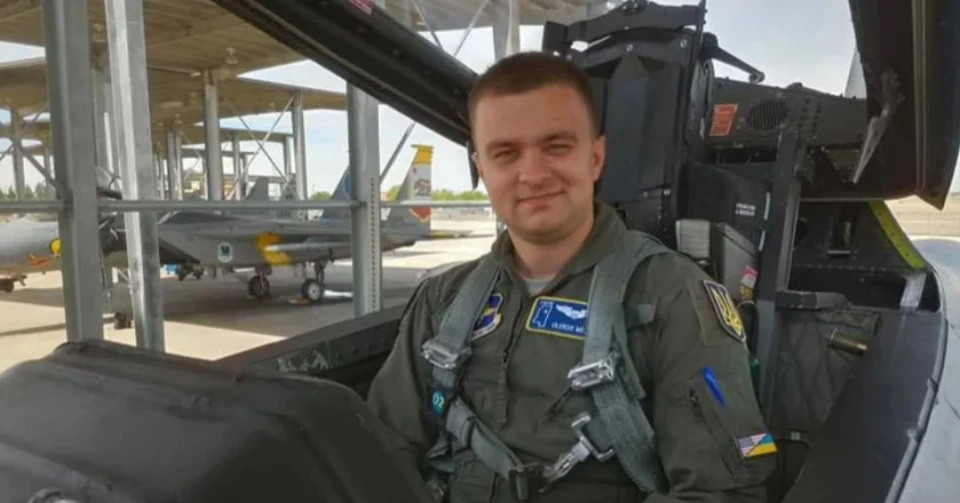
F-16 pilot Oleksii Mes' death is loss for entire Ukraine. Serhiy Zgurets' column
On August 26, F-16 fighter jets were used for the first time to repel a combined Russian attack against Ukraine. Pilot Oleksii Mes, callsign 'Moonfish', lost communication and later crashed. He was buried in Lutsk on August 29
F-16 pilot Oleksii Mes' death is an emotional loss for the whole country
Protecting Ukraine's skies and ensuring the safety of our citizens comes at a significant cost. We all already know that on August 26, F-16 fighters of the Ukrainian Armed Forces were used for the first time to repel Russia's largest combined attack against Ukraine together with anti-aircraft missile units. According to the General Staff, the F-16s shot down four Russian cruise missiles. During the approach to the next target, connection with one of the aircraft was lost. As it turned out later, the plane crashed, and the pilot was killed. It was fighter pilot Oleksii Mes with the call sign 'Moonfish'. The pilot was buried in Lutsk on August 29.
This is indeed a profound emotional loss for the entire country. Oleksii Mes was a warrior who played a key role in reequipping the Ukrainian Armed Forces with F-16 aircraft. He was part of the first group of pilots trained abroad. You may have seen him on our broadcast, where he calmly and enthusiastically talked about mastering the American fighter jet. He mentioned that he eagerly awaited returning to Ukraine with the new planes. Shortly after returning to Ukraine, he participated in combat missions. In his last battle, he destroyed three Russian cruise missiles and one Shahed at the cost of his own life.
 F-16 pilot Oleksii Mes (photo: Serhiy Pohrebetskyi)
F-16 pilot Oleksii Mes (photo: Serhiy Pohrebetskyi)
We don't know what happened to the plane and the pilot right now. Yesterday, the former Commander of the Air Force, Lieutenant General Mykola Oleshchuk, assured that the causes of the F-16 fighter jet crash will be established.
An investigation is underway with the involvement of our American partners. We will certainly find out the causes of this aviation crash. The Ukrainian military command is considering various versions of the crash and the loss of the pilot. However, all this will be determined based on the results of the commission's work. It is also worth mentioning that the former Air Force Commander had to respond to the accusations of some Ukrainian politicians that he was allegedly concealing information about the crash of the F-16 combat aircraft. In my opinion, such accusations against the military are completely inappropriate, as is the discussion of rumors and versions by people who do not have access to real information. “We have lost a trained pilot, we have lost an airplane, but we have not lost our humanity and faith in victory.” These words of Mykola Oleshchuk, I think, absolutely reflect the current state of affairs and the attitude towards this tragic event. Now we need to analyze it, identify the causes and move forward, keeping in mind the price of every day for this war, for our country and for each of us.
UAV operators' work in Bakhmut direction
Denys Kardash, chief sergeant of the Black Raven battalion, said that his unit has been performing tasks in the Bakhmut direction for over a year. In particular, in the area of Klishchiivka and Andriivka. According to him, there is enough work in this area of the frontline, and the load on the unit's soldiers is very high. He emphasized that they are at the stage of forming a battalion and therefore have enough tasks today. People are being trained in combat conditions and everyone is performing their tasks in a coordinated manner.
Denys Kardash said that the Russian forces are trying to advance in the Bakhmut direction and their resistance is also very strong. The occupiers also have a considerable arsenal of UAVs, which they use against Ukrainian units. UAV pilots are constantly forced to change and disguise their positions to effectively target the occupiers.
According to Denys Kardash, the main target for FPV drones is guns and any type of Russian equipment. During the assault on the enemy, the main target for UAV operators is the occupiers' personnel. UAV operators use FPV drones with multiple drops to target the Russian occupation personnel. As for payments from the state for destroyed equipment, Kardash said that such incentive money has been paid before. Previously, payments were received only for destroyed equipment, but now UAV operators receive monetary rewards for the destruction of occupation personnel. However, the payment process is very long. Kardash noted that they are counting on these payments, but not very much. Because UAV operators work not for the sake of money, but to destroy the enemy and liberate Ukrainian lands.
Denys Kardash commented on the use of fiber optic drones. According to him, such drones are very convenient for working at short distances. He noted that today there are already experts who are developing a different kind of communication for drones, which is also very necessary. This will allow them to work without the influence of Russian electronic warfare, and will also change the tactics of use.
Drone tactics change every week
Denys Kardash emphasized that the tactics of using drones change almost every week. Not only by Ukrainian Defense Forces, but also by the Russians. Many methods that worked a month ago no longer work effectively. According to Kardash, it is necessary to constantly change the way drones are used, and most importantly, to improve UAV operators' camouflage. He also added that there is a problem with electronic warfare. “The use of electronic warfare has become uncontrolled and often the same electronic warfare system works against its own drones. Now everyone is trying to buy the maximum number of electronic warfare devices. Almost every vehicle and position is equipped with electronic warfare systems. Although this is very good, as Kardash noted, it interferes with the work of a drone operator. They are trying to solve this problem, but so far without success.
Denys Kardash said that all the drones donated by volunteers do not have to be adapted to the tasks they are supposed to perform. Sometimes there are exceptions, but mostly they get what they asked for. The drones the unit receives from the state are split 50/50. That is, almost half of them need to be customized in a workshop that works around the clock. According to Kardash, sometimes they receive a batch of drones from the state that require little or no modification at all, and the UAVs fly perfectly. Sometimes, the entire batch needs to be completely modified and adapted for combat missions.
According to Kardash, the lives of his own soldiers have always come first when it comes to ammunition, initialization and safety of the unit. That's why the battalion commander is very careful about this. Kardash said that they take the ammunition ready-made. They also adapt the ammunition themselves to the tasks performed by the unit. This process is unified. That is, all UAV operators who go on a combat mission know how to work.
- News










































